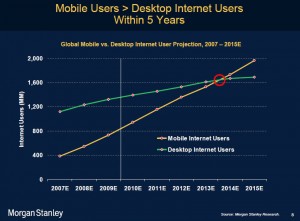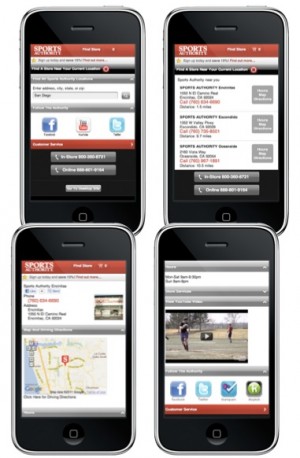Increase Retail Sales From Mobile Devices In 2012
2011 was the year that shopping on mobile devices moved into the mainstream. It won’t be long before the majority of retail sales are made from tablets and mobile devices rather than laptops and desktops. With mobile usage increasing dramatically in 2012, it’s important for retailers to start accommodating mobile shoppers. This article will review […]
2011 was the year that shopping on mobile devices moved into the mainstream. It won’t be long before the majority of retail sales are made from tablets and mobile devices rather than laptops and desktops.

With mobile usage increasing dramatically in 2012, it’s important for retailers to start accommodating mobile shoppers.
This article will review mobile trends of interest to retailers, offer some tips for going mobile, and include some information on Mobile Store Locator Software for multiple location retailers.
First, let’s start with some mobile stats that impact retail sales:
- Over 1 billion of the worlds 4+ billion mobile phones are smartphones with 3 billion SMS enabled
- In the US, 9 out of 10 people are mobile subscribers
- 79 percent of smartphone owners use their phones to help with shopping
- In 2011, over 50 percent of all local searches were conducted from a mobile device
- Tablets are rapidly replacing laptops and will total 100+ million globally by year end
- Tablets made major inroads in retail: 77 percent of all mobile traffic is from tablets
- In 2014, mobile Internet usage will overtake desktop Internet usage (est.)
- 86 percent of mobile users are watching TV while using a mobile phone
- More than 350 million active users access Facebook through mobile devices
- On average, Americans spend 2.7 hours per day socializing on mobile devices
- 29 percent of mobile users would scan a mobile tag to get coupons to be redeemed instantly in store
Consumers Use Mobile Devices In Store To Check Prices & Inventory
Next, we want to talk about how consumers are using mobile devices when shopping. In the future, it will become common place for consumers to use mobile devices to guide purchasing decisions as retail employees use them to check inventory and pricing.
According to the Motorola Solutions 2011 Holiday Shopping Survey, consumers and retail employees want to use smartphones to find product information inside stores.
The trend toward using mobile devices to find prices, product reviews and item availability, and then using that information to make purchase decisions was highest among consumers in the mid-20s to mid-30s age range, said the report, which also found:
- 43 percent of shoppers want to use a mobile app to find items in the aisles
- Nearly 11 percent of consumers have used smartphones in store for purchase decisions
- Retail employees (71%) want to use store-provided mobile devices to check inventory for shoppers
“The majority of retail associates feel they would benefit from a widely deployed mobile device with inventory and price-checking applications,” said the report.
Tips For Reaching Consumers Across Devices
The average consumer uses multiple devices and/or browsers during the purchase cycle. For that reason, retailers must ensure a good consumer experience on all devices.
When it comes to advertising, retailers must plan targeted campaigns to reach shoppers on mobile devices. Text messaging (SMS) is one option for providing instant communication to shoppers on the go.
It’s important to offer your customers something of value with a strong call to action encouraging them to buy. Retailers could reach out to their customers once a month with mobile coupons, discounts or other incentives and rewards.
Tailoring your advertising campaigns to mobile users is also important. Retailers must reach the consumer in a manner consistent with the way their devices are used. For instance, focus on short text as query length is generally shorter.
- Text messages get read over 96 percent of the time with 8 times the redemption rate of email
- Create focused, mobile-only campaigns that reach your audience with unique offers
- Schedule text messages to coordinate with important events and promotions
- Send automated followup messages when mobile users have engaged in a transaction
- Reach mobile users when they approach your store using geo-locating technology
Before you advertise, first ensure you have a mobile friendly website. With more consumers using mobile devices, retailers must maintain a user-friendly mobile presence. Your conversion rates will double from your previous rates once you optimize for mobile users.
Optimizing Your Website To Accommodate Mobile Shoppers
Despite the increases in smartphone and tablet traffic, retailers are not yet prepared to accommodate mobile shoppers. Many retail sites have text and images that are not suitable for the small screen, making pages slow to load and hard to read with minimum functionality.
In a survey of over 4,000 mobile Web users, 74 percent said they would only wait 5 seconds or less for a single webpage to load before leaving the site. You need a mobile site that offers a good user experience and seamless transactions.
Retailers with multiple locations may consider employing mobile storefront software which automatically builds an entire mobile web-formatted store locator platform based on your existing business location data, accommodating mobile users by GPS location, IP address, city, state, zip code, neighborhood or street address, and promotes social sharing.
As you can see below, the user experience with the mobile store locator allows users to see all tabs on one page rather than having to click through several mobile pages to find what they’re looking for. Not only that, all tabs have user analytics reporting the number of clicks to Maps, Directions, Specials, Coupons, Rich Media, etc.
When it comes to your mobile presence, you have three options of mobile functionality to choose from: 1) redirecting your website for mobile users to a mobile version of your site, 2) building a mobile website and, 3) building a mobile app.
You’ll get your greatest reach with a mobile website, and many of your loyal consumers will use your app. Below is a quick checklist.
- Style Sheets: To render your mobile website properly on mobile devices, you’ll need two style sheets: one for the iPhone and one for all other handhelds.
- Think Small: Because mobile users have little patience, make your site simple and user friendly for the small screen. Consumers want basic information like product, price, hours of operation, specials, coupons, etc.
- Webpage Design: Create mobile pages for a screen size of 320 by 240 pixels. Use Alt tags for images. Don’t use tables, large images, frames or lengthy text.
- Mobile Sitemap: Create a site map so crawlers can find you and include the sitemap link in your robots.txt file.
- Local Search Submission: Display your business on Google Places, Yahoo Local and Bing Business Portal with map, directions, etc. in search results.
- Test: You can submit your site to the Gomez Mobile Website Performance Test to see how well it performs.
In conclusion, 2012 will certainly be the year that retailers must focus on mobile users by reaching out to them across devices with a mobile optimized website. Being aware of the many trends reviewed above can help you increase retail sales throughout the year.
Disclosure: I advise firms that provide and/or distribute digital storefront software.
Contributing authors are invited to create content for Search Engine Land and are chosen for their expertise and contribution to the search community. Our contributors work under the oversight of the editorial staff and contributions are checked for quality and relevance to our readers. The opinions they express are their own.
Related stories
New on Search Engine Land

